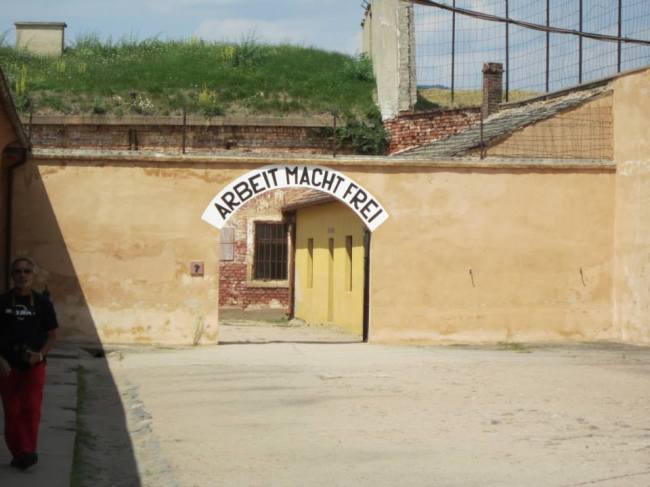We started rather early today, rushing to the metro around 9 in the morning in order to make it on time to start our field trip for our Jewish Studies class. Our first stop was the Ss. Cyril and Methodius Cathedral, which has a small museum dedicated to Czech and Slovak heroes from World War II. Two soldiers, a Czech and a Slovak, had escape to the United Kingdom and were chosen for the planned assassination of Reinhard Heydrich, who was considered to be the second most vile Nazi, right after Adolf Hitler himself. Upon assassinating Heydrich in Prague, Jozef Gabčík and Jan Kubiš were hidden along with 3 other soldiers by the monks of the Cathedral until a fellow soldier, who had sought refuge with his mother, betrayed their location to the SS. We also watched a 40 minute film on the assassination before heading into the crypt where the soldiers lived, The crypt was everything you’d expect- dirty, dark, and cold.
Once we were done with the museum and crypt, we took a small bus to Terezín concentration camp. Terezín is unique from other concentration camps in that it was not only a transit camp (basically, a stop on their way to death), but the captive Jews had a considerable amount of freedom compared to the other camps. Though the “residents” always had the fear of being deported and/or killed in their minds, the captives consisted of intellectuals, artists, and musicians. They wrote poems and stories, drew pictures, put on plays, and played music- and the Nazis allowed them to. The main reason was a show of face: the International Red Cross came to visit Terezín, so the Nazis made it look like they had “given” this town to the Jews, as evident by the propaganda film we watched in Terezín called “The Gift of a Town”, which portrayed the Jewish residents as happy and active. The International Red Cross at this time must have consisted of members who were pretty stupid, because the whole “Red Cross coming to visit a concentration camp and finding it to be acceptable” just flat out baffles me more than the Holocaust itself. Were they just plain unaware that there were concentration camps? Did they think it was just a town reserved for just Central European Jews, like the Native America reservations in the United States?
Anyways, our teacher managed to get one of the tour guides to give us a group tour, so she showed us around Terezín fortress, which was no where near as pleasant as Terezín town. Unsurprisingly, the Jews at the fortress lived in appalling conditions, while across the street, their Nazi guards and their families lived in luxury. The last thing we did before we left Terezín was watch a short movie on the drawings and writings of children in Terezín. The art of the children was both creative and eyeopening. While some of them drew their surroundings and revealed the truth about life in the camp, others drew whatever they imagined, be it heroes fighting monsters or children playing with flowers and kites.
Up until we reached the small fortress, Terezín was considerably less depressing than Dachau, which I visited in 2009 with my family while we were on our week long vacation to Munich, Germany and Salzburg, Austria. Even so, it still did not feel quite right when my group sat down in the town and ate lunch in the grass as if we were having a picnic.

